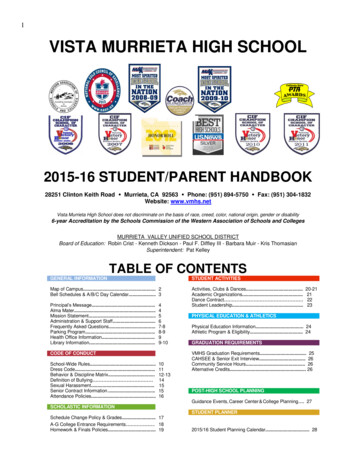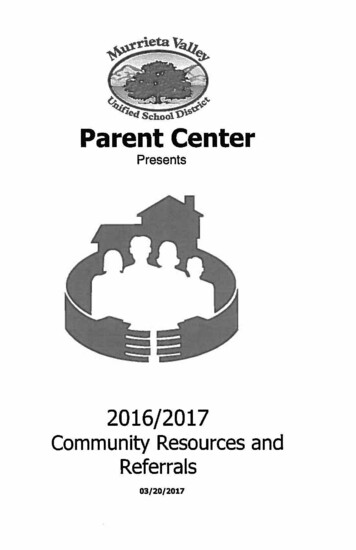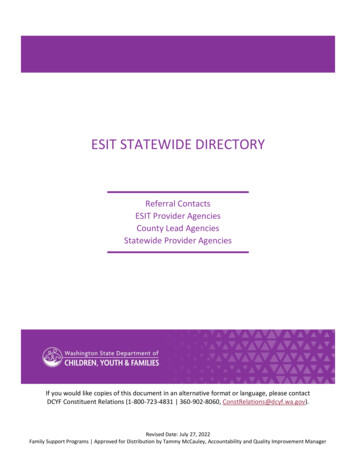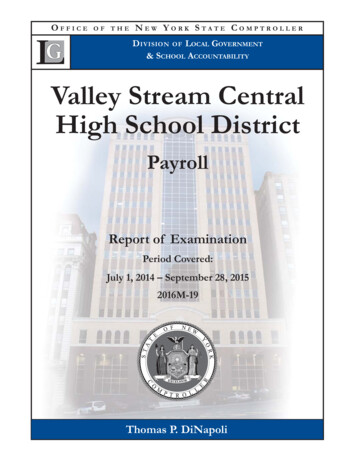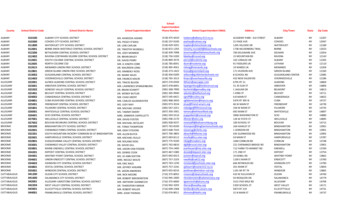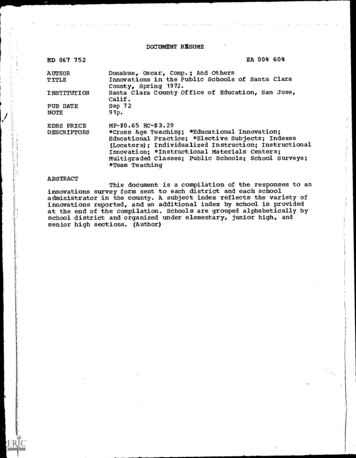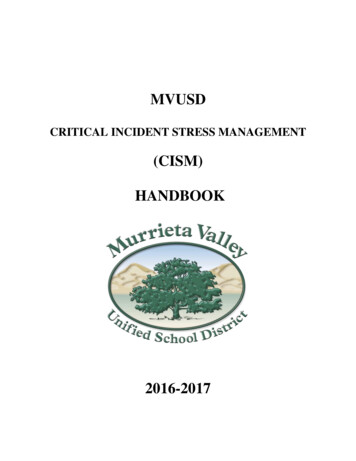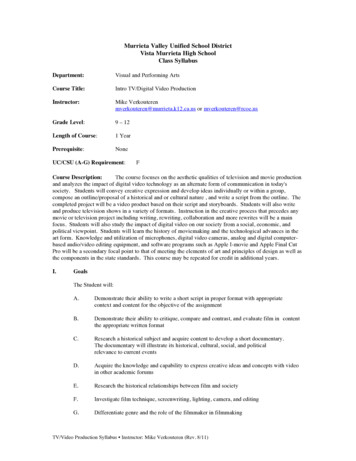
Transcription
Murrieta Valley Unified School DistrictVista Murrieta High SchoolClass SyllabusDepartment:Visual and Performing ArtsCourse Title:Intro TV/Digital Video ProductionInstructor:Mike Verkouterenmverkouteren@murrieta.k12.ca.us or mverkouteren@rcoe.usGrade Level:9 – 12Length of Course:1 YearPrerequisite:NoneUC/CSU (A-G) Requirement:FCourse Description:The course focuses on the aesthetic qualities of television and movie productionand analyzes the impact of digital video technology as an alternate form of communication in today'ssociety. Students will convey creative expression and develop ideas individually or within a group,compose an outline/proposal of a historical and or cultural nature , and write a script from the outline. Thecompleted project will be a video product based on their script and storyboards. Students will also writeand produce television shows in a variety of formats. Instruction in the creative process that precedes anymovie or television project including writing, rewriting, collaboration and more rewrites will be a mainfocus. Students will also study the impact of digital video on our society from a social, economic, andpolitical viewpoint. Students will learn the history of moviemaking and the technological advances in theart form. Knowledge and utilization of microphones, digital video cameras, analog and digital computerbased audio/video editing equipment, and software programs such as Apple I-movie and Apple Final CutPro will be a secondary focal point to that of meeting the elements of art and principles of design as well asthe components in the state standards. This course may be repeated for credit in additional years.I.GoalsThe Student will:A.Demonstrate their ability to write a short script in proper format with appropriatecontext and content for the objective of the assignmentB.Demonstrate their ability to critique, compare and contrast, and evaluate film in contentthe appropriate written formatC.Research a historical subject and acquire content to develop a short documentary.The documentary will illustrate its historical, cultural, social, and politicalrelevance to current eventsD.Acquire the knowledge and capability to express creative ideas and concepts with videoin other academic forumsE.Research the historical relationships between film and societyF.Investigate film technique, screenwriting, lighting, camera, and editingG.Differentiate genre and the role of the filmmaker in filmmakingTV/Video Production Syllabus Instructor: Mike Verkouteren (Rev. 8/11)
II.ObjectivesObjectiveStudents will increase their knowledge and appreciation of the filmmaking processthrough observation, discussion, comparison, and written evaluation. Introducestudents to concepts of genre and the filmmaker. Student output will become partof an ongoing electronic portfolio.VPA Standards1.5; 1.6; 3.2; 3.3;3.4; 2.2Students will observe created works by masters and technicians in film andtelevision. Students will analyze the process of creation and apply that knowledgeto original work of their own. Students will create a Public Service Announcement,a commercial, a demonstration video, a historical documentary, and other creativeassignments. Past projects will be reviewed by students late in the year to articulatehow they would improve their work given the extent of experience.2.1; 2.2; 2.3; 2.6;4.4; 5.2;Students will read selected short stories and will chose a story to interpret into ascript using the proper format. Script will address all phases of the filmmakingprocess from acquisition to final production. Students will discuss how writtenworks are interpreted as film and how that interpretation affects the process ofmaking a film or television show. How trends or historical issues have influencedthe films made or how they used to investigate social issues. ( Example: warmovies, or movies of the depression era.)2.1; 2.2; 3.3; 4.1;4.2; 5.2;Compare and contrast films by varied filmmakers that address a similar message.Students will evaluate the methods used and describe how they affected the messageof the film. Students will evaluate films generally accepted as classics and howthose films were accepted when made and how time has effected their laterinterpretation. Compare and contrast how television (broadcast and cable),newspapers, magazines, and film, cover and interpret current or historical social,economic, or political events2.1; 2.2; 5.3Students will learn to use the digital tools available to create and edit video. Thosewill include the video camera, computer editing software, and other digital tools.Students will learn how those digital tools have affected changes in the process offilmmaking.2.2; 3.2III.Outline of Content for Major Areas of Study (Schedule is subject to change)Semester I – All scripts and outlines must be typed in the correct formats.A.First 6 Weeks1.Intro / Mac / Final Cut Pro / Scriptwritinga.Basic computer operations.b.Begin individual digital portfolios.2.Intro to TV Studio – (200 pts.)a.Control room, cameras, and microphones.b.Model 3-minute script from newspaper, Internet, and schoolnews. (100 pts.)c.Students write short news program based on local and schoolevents. (100 pts.)d.News from local paper, Internet. School sports and activities.e.Add assignment to portfolio.3.Public Service Announcement. – (200 pts.)a.Model: show PSA’s from a web source.b.Model script and storyboard. (100 pts.)c.Students work in groups of 2, complete their own PSA.(100 pts.)d.Add assignment to portfolio.TV/Video Production Syllabus Instructor: Mike Verkouteren (Rev. 8/11)
B.Second 6 Weeks1.Commercial – (200 pts.)a.View commercials from 1960’s and Macintosh commercialsb.Model: pick a list of products.c.Model script and storyboard. Use stock footage to completevideo commercial. – (100 pts.)d.Students work in groups of 2 to conceptualize and produce: 30second commercial. – (100 pts.)e.Add assignment to portfolio.2.Flash MX / Adobe ImageReady – (200 pts.)a.Introduction to computer animation – (200 pts.)b.Add assignment to portfolio.C.Third 6 Weeks1.Instructional Video – (500 pts.)a.Preview “Demonstration” video to students.b.Model steps to create a “how to” video from school activities.c.Model the process of scripting, storyboarding, taping, andediting. (100 pts.)d.Students conceive idea and outline their project. (100 pts.)e.Students write 4 to 10 page script and assemble storyboard.f.Assemble video clips and edit. (300 pts.)g.Add assignment to portfolio.2.History Documentary – (500 pts.)a.Preview short documentaries in class. Examples of severaltypes.b.Show Documentary on making of Citizen Kane. Movie to beseen later in year. Read: http://www.pbs.org/wgbh/amex/kane2/c.Model how to find a relevant historical subject and create a tenminute documentary.i.Research the subject in the library, Internet, andinterview subject. (100 pts.)ii.Finds photo’s, video clips, primary and secondarysources suitable for use. (100 pts.)iii.Assemble the documentary according to NationalHistory Day rules and regulations. (100 pts.)d.Student research possible subjects for an extensive list.e.Research their ideas and reduce possible subjects to one.f.Assemble documentary and add relevant interviews and voiceovers. (200 pts.)g.Add assignment to portfolio.Semester II – All scripts and outlines must be typed in the correct formats.A.First 6 Weeks1Introduce Final Cut Pro – (500 pts.)a.Convert video editing from iMovie to Final Cut Pro.b.Demonstrate differences and added features.2.Conducting an Interview-studio or remote – (500 pts.)c.View model interviews from 60 Minutes, Today, and cableshows.d.Demonstrate how to interview. Pick the subject, research; writequestions, with possible answers. Determine if this is a friendlyor hard-hitting interview.TV/Video Production Syllabus Instructor: Mike Verkouteren (Rev. 8/11)
e.3B.Second 6 Weeks – (500 pts.)1Talk/Discussion Show in Studio Music video – (500 pts.)a.Class will view examples from TV talk show formats.b.Model to conception, outline, and scripting of a sample roundtable discussion on a school related subject.c.Students work in groups of 4 to conceive and write their own 10minute talk show. – (100 pts.)i.1 group on air while a second group helps with thetechnical side of the broadcast.d.View each groups finished show in class. (400 pts.)e.Add assignment to portfolio.2C.Students use their partner to conduct a sample interview.Demonstrate questioning techniques. (100 pts.)f.Students select someone outside of class to interview. Partnerwill tape while they conduct the interview. Review questions inclass, peer review then whole class review. Revise questions.g.View completed interviews in class. (400 pts.)h.Add assignment to portfolio.Music video – (500 pts.)a.View music videos from MTV. Show previous student work.b.Model music video with MP3 music.i.Select song.ii.Outline/propose the project.iii.Edit video from stock footage.c.Have students listen to samples of available music.d.Students select a song and search for lyrics. – (100 pts.)e.Students write outline/proposal. – (100 pts.)f.Students write script. Script revision. – (100 pts.)g.Shoot video.h.Edit and show to class. (200 pts.)i.Add assignment to portfolio.Create an Alternate Ending - Writing Assignment (10 days) – (200 pts.)a.View alternate endings from directors cut of two movies.b.Model how to change an ending at the climax.c.Students chose a movie from the AFI top 100 and rewrite anending starting at the climax. – (200 pts.)d.Add assignment to portfolio.Third 6 Weeks – (800 pts.)1.Key Assignment – Students will do a research project withhistorical/cultural context and through creative expression will develop ashort film related to the topic researched. – (800 pts.)a.Students will complete a ten-minute short film produced by eachgroup.b.Model the conception process with students. Using “Inspiration”brainstorm as many ideas as possible. (100 pts.)c.Students brainstorm as a class. Students should contribute oneidea each. Link ideas to add twists and turns to the story.d.Students will work with instructor to begin a short film scriptfrom their idea. Each class will do their own script. Work as agroup until they complete 5 pages. (100 pts.)e.Split class into groups of 5 and each group will complete theirown script. Each story will begin the same and end differently.TV/Video Production Syllabus Instructor: Mike Verkouteren (Rev. 8/11)
f.2.3.IV.Bring groups back together and compare scripts. Groups willrevise where necessary. Points to check: 3 acts, characterdevelopment, twists and turns in act II. Check they each have atrue ending for their story.g.Groups will videotape their scripts. (100 pts.)h.Any revisions must be added to their shooting script.i.Create a 1-minute preview for their short film. (300 pts.)j.Create movie posters and radio add campaign. (200 pts.)k.Add assignment to portfolio.Review for final exams.Comprehensive Final ExamsGradesProjects (Subject to Change)PointsClass Participation & Discussion 360 pointsTests(Midterm & Final Exam) 500 pointsQuizzes (Textbook/Unit Lesson Reviews) 800 pointsAssignments and Critiques1st Semester (Video Projects) 2000 pointsIntro to TV Studio – (200 pts.)Introduce Final Cut Pro – (200 pts.)Public Service Announcement. – (200 pts.)Commercial – (200 pts.)Introduction to computer animation – (200 pts.)Instructional Video – (500 pts.)History Documentary – (500 pts.)(18 weeks x 20 pts.)(2 x 250 pts.)(8 x 100 pts.)2nd Semester (Video Projects) 3000 pointsAdvanced Final Cut Pro – (500 pts.)Conducting an Interview-studio or remote – (500 pts.)Music video – (500 pts.)Talk/Discussion Show in Studio Music video – (500 pts.)Create an Alternate Ending - Writing Assignment (10 days) – (200 pts.)Key Assignment – Students will do a research project with historical/cultural context and through creativeexpression will develop a short film related to the topic researched. – (800 pts.)1st SEMESTER TOTAL POINTS2nd SEMESTER TOTAL POINTS 3660 points 4660 pointsThe Final Grade is based upon a percentage computed by dividing the number of points accumulated by thestudent by the total number of points available. The percentage is then converted to the letter grades asfollows:A 90-100%, B 80-89%, C 70-79%, D 60-69%, F 0-59%SINCE THIS IS A “HANDS-ON” COURSE, ALL LABORATORY EXERCISES/PROJECTS MUST BECOMPLETED AND TURNED IN. FAILURE TO SUBMIT A LABORATORY EXERCISE, WILLRESULT IN A “0” GRADE FOR THAT PARTICULAR ASSIGNMENT IN THE ABOVECALCULATION AND WILL THEREFORE, RESULT IN A LOWER FINAL GRADE.TV/Video Production Syllabus Instructor: Mike Verkouteren (Rev. 8/11)
Grades assume completion, including on-time submittal, of assignments. Late assignments will have gradesdiscounted by a minimum of 25% of the total available for the assignment for each day past due date.Class activities and assignments, including unannounced quizzes, etc. will not be accepted late and cannotbe made-up. The student is expected to attend all classes. Tests may be made-up if the student is absentAND HAS NOTIFIED THE INSTRUCTOR PRIOR TO THE ABSENCE to provide a justifiable reasonfor his or her absence. The acceptance of the excuse and the eventual make-up of a test is at the discretionof the instructor. The instructor will give unannounced quizzes on occasions. Tests may include computerbased activities.V. TextTelevision Production :A Comprehensive On-line Cyber Text in Studio and Field ProductionBy Ron Whittaker, Ph.D.Elements of Mass Communication: An Interactive Cyber Text ; By Ron Whittaker, Ph.D.Video Communication & Production, by Jim Stinson, Goodheart-Willcox Company, Inc ISBN: 1-56637-798-6Television Production Handbook, Herbert Zettl Thomson/Wadsworth, ISBN: 0-534-64727-8orWebsite links maintained by Ron Whittaker, Ph.D.Main Site: http://www.cybercollege.com/indexall.htmTV Productionhttp://www.cybercollege.com/tvp ind.htmMass Mediahttp://www.cybercollege.com/frtv/frtv ind.htmVI. Supplementary Classroom Equipment & MaterialsIMPORTANT – Personal Student Head Phones Daily- MUST HAVE (1/8” standard jack), StudentDigital Video Camcorder (If available as needed), Digital Still Camera (If available as needed), 10 - DVDR’s to record your completed movie projects, 5 – CD-R’s for iPod format Quicktime movies.VII. Behavior Policy (Please see the attached “Classroom Safety, Behavior& Daily Business Policy” document)VIII. Equipment Responsibility (Please see the attached ”Equipment Responsibility “document)TV/Video Production Syllabus Instructor: Mike Verkouteren (Rev. 8/11)
TV/Video Production Syllabus Instructor: Mike Verkouteren (Rev. 8/11) II. Objectives Objective VPA Standards Students will increase their knowledge and appreciation of the filmmaking process through observation, discussion, comparison, and written evaluation. Introduce students to concepts of genre and the filmmaker.
